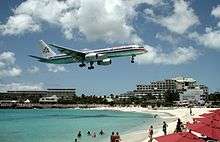Tourism in the Caribbean
 |
.jpg) |
Clockwise, from upper left:
| |
Tourism is one of the Caribbean's major economic sectors, with 25 million visitors contributing $49 billion towards the area's gross domestic product in 2013, which represented 14% of its total GDP.[1] It is often described as "the most tourism-dependent region in the world".
The first hotel was built on the island of Nevis in 1778 and brought wealthy visitors, such as Samuel Taylor Coleridge. In the 19th century, resort hotels were also built on The Bahamas, Jamaica and Barbados to support an increasing tourist trade. Tourism increased dramatically when airplanes transported tourists to the region. This increased the numbers of people that were able to afford to vacation on the islands, but required costly infrastructure development.
History


The early seaside resorts were developed primarily for curative benefits of bathing[lower-alpha 1] in the sea and breathing the warm, ozone-laden air.[3] Lawrence Washington (1718–1752) and his younger half-brother George Washington stayed at the Bush Hill House in Barbados in 1751 for two months to treat Lawrence's tuberculosis. According to an Anthropologist, Barbados was referred to as the "sanatorium of the West Indies" in guidebooks because of its fresh water, sea air, and absence of malaria.[3]
The Bath Hotel and Spring House was built of stone along Bath Stream in 1778 on the island of Nevis.[4] It was the first official hotel to open in the Caribbean.[5] The mineral hot springs and the hotel attracted visitors such as Prince William Henry, Lord Nelson and Samuel Taylor Coleridge.[4] The Royal Victorian Hotel in the Bahamas opened in 1861, Crane Beach in Barbados opened in 1887, and the Jamaican Titchfield Hotel was another early one.[6] By 1900, eleven or more steamships had regular routes to Barbados. In the 19th century, wealthy European tourists traveled across the Atlantic during the winter months for weeks or months at a time.[3][5] The Caribbean islands were colonies of European countries, and early tourists went to their nation's colonies. Barbados and Jamaica were visited by the English, Curaçao by the Dutch, and Martinique by the French.[7] American tourists traveled to The Bahamas and Cuba.[3]
In the 1920s, tourists visited the Caribbean for pleasurable, sun-bathing vacations. Sun exposure was considered healthy at that time and tans were a symbol of "spontaneity and sensuality" among the wealthy.[8] Before World War II, more than 100,000 tourists visited the region a year.[9]
Tourism became an economically important industry as Caribbean bananas, sugar, and bauxite were no longer competitively priced with the advent of free-trade policies.[4][10] Encouraged by the United Nations and World Bank, many governments in the Caribbean encouraged tourism beginning in the 1950s to boost their third-world economies.[11] The Caribbean Tourist Association was founded in 1951.[12] Tax incentives encouraged foreign development of hotels and infrastructure, cultivated by newly formed tourism ministries.[10]
Regular non-stop international airplane flights in the 1960s made vacations to the Caribbean more affordable and increased the number of visitors.[6] Visitors from Europe could travel there in eight hours, whereas it used to take three weeks by ship.[8] After World War II, the expanding middle class had more time and money for vacations and travel agencies sold affordable vacation packages to the Caribbean. Friendly native people, a warm climate, very few pests or disease, and natural beauty made it an attractive holiday option. In addition, people could also select islands based upon the language spoken: Spanish, French, Dutch or English.[8] In 1959, 1.3 million people vacationed in the Caribbean, and by 1965 the number of visitors had risen to nearly 4 million per year.[9]
Multinational hotel chains and tour operators began operating.[6] Tourism became a significant industry by 1985 when 10 million people vacationed on the islands.[9] Islands that had relied on oil production for their revenue, like Trinidad and Tobago, and Aruba, did not vigorously promote tourism until revenues from oil declined in the 1990s.[9] In 2007, the number of annual tourists rose to 17 million people.[9]
Economy
Tourism is one of the region's major economic sectors, with 25 million visitors contributing $49 billion towards the area's gross domestic product in 2013, which represented 14% of its total GDP. This puts the region twelfth in the world in terms of tourism's absolute contribution to GDP, but first as a proportion of GDP. In terms of employment, 11.3% of the region's jobs depend on tourism either directly or indirectly.[1] It is often described as "the most tourism-dependent region in the world".[13][14][15]
Caribbean islands now depend on tourism for their economy, it being referred to as "the engine of their growth".[16] Tourism is a huge contributor to the economies of all Caribbean countries and the biggest contributor to many of them such as Antigua and Barbuda, Bahamas and the Virgin Islands. It provides a steady revenue stream, with temporary blips due to hurricanes or recessions in the Western world[17] and supports local farming, fishing, and retail industries.[18] Barbados, for instance, has moved from a primarily agricultural economy to a service-based economy that supports tourism. By 2006, tourism brought in ten times more to the Barbados economy than sugar cane production, $167 million versus $14.5 million.[19]

Besides hotels and restaurants, services to tourism have required additional infrastructure, including: airports, roads, sewage treatment plants, landfills, electricity supply and telephones.[20]
Much of the profit from tourism is earned by corporations outside of the Caribbean since, "two-thirds of the hotel rooms in the region are foreign owned, and the tour companies who arrange visitor's activities are often foreign owned".[20] The more luxurious the accommodations, the more likely that profits are made by foreign firms. Further, many resorts are all-inclusive, and vacationers of these resorts rarely eat out at locally owned restaurants, rent water sports gear from local entrepreneurs, or arrange island tours with local taxis.[21] Most of the food served at hotels is imported, locally grown fruit, such as breadfruit, bananas, mangos, and citrus is rarely served. Only about 30% of money spent by foreign visitors remains in the Caribbean, the rest is retained by overseas firms.[21]
Tourism development has driven up the cost of food and land, land which may be purchased for hotel, marina, and other tourist facility development by companies able to afford the price.[22] If they have a home, they may be pushed out of their residence due to the high cost of living or hotel construction.[22]
Today some West Indians are seeing features of the colonial situation resurrected by tourism. Locals are denied access to their own beaches, the best jobs go to non-nationals or those with the lightest skin, and humble service roles and low-wage jobs predominate in the tourism sector.— George Gmelch, 2012[23]
Attractions
Tourist attractions of the region are those generally associated with a maritime tropical climate: Scuba diving and snorkeling on coral reefs, cruises, sailing, and game fishing at sea. On land; golf, botanical gardens, parks, limestone caves, wildlife reserves, hiking, cycling and horseback riding. Cultural attractions include Carnival, steel bands, reggae and cricket. Due to the dispersal of the islands, helicopter or aeroplane tours are popular. Specific to this tropical region are tours of historic colonial plantation houses, sugar mills and rum distilleries.[24] Caribbean cuisine is a fusion of cooking styles, goat stew being the signature dish of several islands. Marijuana has developed in importance since the 19th century, becoming a significant part of Jamaican culture.[25]
A large number of the visitors are honeymooners or people who come to the islands for a destination wedding.[11] Tour operators use oblique references to sex tourism to attract customers.[26] The sex trade is an unquantified part of Caribbean tourism in which older women from North America and Europe are the clients.[27]
Cultural impacts
Some historians and cultural anthropologists say the changes to the islands to support tourism have negatively impacted the indigenous cultures of the Caribbean.[12] David Bennett's article, "Global tourism and Caribbean culture" offers examples in which tourism and globalization create an inauthentic culture that caters more to the tourists than the indigenous heritage. This is further morphed by mass media influences, such as television and the Internet.[12] Trinidad's traditional carnival has become an inauthentic commercialized event used to lure tourists for economic gain.[28] Historically, the festival emphasized a mythological basis, demonstrating the holy trinity and the nation's unity.
See also
Notes
- ↑ Early tourists avoided exposure to the sun, since wealthy people were distinguished by light skin since they did not work in the sun and also believed there were ill effects of being in the sun, and did not have bathing suits. So, they bathed naked in the sea during the early morning or late afternoon and under shaded structures, like gazebos, verandas, and covered walkways.[2]
References
- 1 2 Rochelle Turner (2014). Travel & Tourism, Economic Impact 2014, Caribbean (Report). World Travel and Tourism Council. p. 1. Retrieved 2014-11-25.
- ↑ Gmelch, p. 4.
- 1 2 3 4 Gmelch, p. 3.
- 1 2 3 "Bath Hotel and Spring House". Nevis. Retrieved November 25, 2014.
- 1 2 Pattullo, p. 8.
- 1 2 3 Pattullo, p. 9.
- ↑ Gmelch, p. 2.
- 1 2 3 Gmelch, p. 5.
- 1 2 3 4 5 Gmelch, p. 8.
- 1 2 Gmelch, p. 7.
- 1 2 Gmelch, p. 6.
- 1 2 3 David Bennett (2005). "Global Tourism and Caribbean Culture". Caribbean Quarterly. 51 (1). Retrieved November 26, 2014 – via Questia. (subscription required (help)).
- ↑ "UK tax threatens Caribbean tourism". BBC News. 2012-02-01. Retrieved 2014-11-25.
- ↑ Pentelow, Laurel; Scott, Dniel J. (May 2011). "Aviation's inclusion in international climate policy regimes: Implications for the Caribbean tourism industry". Journal of Air Transport Management. 17 (3): 199–205. doi:10.1016/j.jairtraman.2010.12.010. Retrieved 25 November 2014.
- ↑ Cummins, Kimberley (21 March 2013). "CTO: Tourism must not fail". Barbados Today. Barbados Today. Retrieved 25 November 2014.
- ↑ Gmelch, pp. 8-9.
- ↑ Pattullo, p. 11.
- ↑ Gmelch, p. 9.
- ↑ Gmelch, pp. 7-8.
- 1 2 Gmelch, p. 10.
- 1 2 Gmelch, p. 11.
- 1 2 Gmelch, pp. 11-12.
- ↑ Gmelch, p. 12.
- ↑ Gmelch, pp. 6, 138.
- ↑ Paulraj, Kavin. "Marijuana in Latin America and the Caribbean: Part I of III". Center for Latin American Studies (CLAS), University of Pittsburgh. Retrieved 30 November 2014.
- ↑ "New Statesman".
- ↑ Bindel, Julie (August 25, 2013). "Thought it was just men who flew abroad for squalid sexual kicks? Meet the middle-aged, middle-class women who are Britain's female sex tourists". Daily Mail.
- ↑ Ehrenreich, Barbara. "Up Close at Trinidad's Carnival". Smithsonian (magazine). Smithsonian Institution. Retrieved 30 November 2014.
Bibliography
- George Gmelch (21 March 2012). Behind the Smile, Second Edition: The Working Lives of Caribbean Tourism. Bloomington: Indiana University Press. ISBN 0-253-00129-3.
- Polly Pattullo (1996). Last Resorts: the Cost of Tourism in the Caribbean. London: Cassell. ISBN 0-304-33693-9.
Further reading
- "Medical Tourism in the Caribbean". caribjournal.com. 2014-11-23. Retrieved 2014-11-25.
- "Turks and Caicos: Caribbean island takes next step into developing medical tourism.". International Medical Travel Journal. 2014-03-05. Retrieved 2014-11-25.
